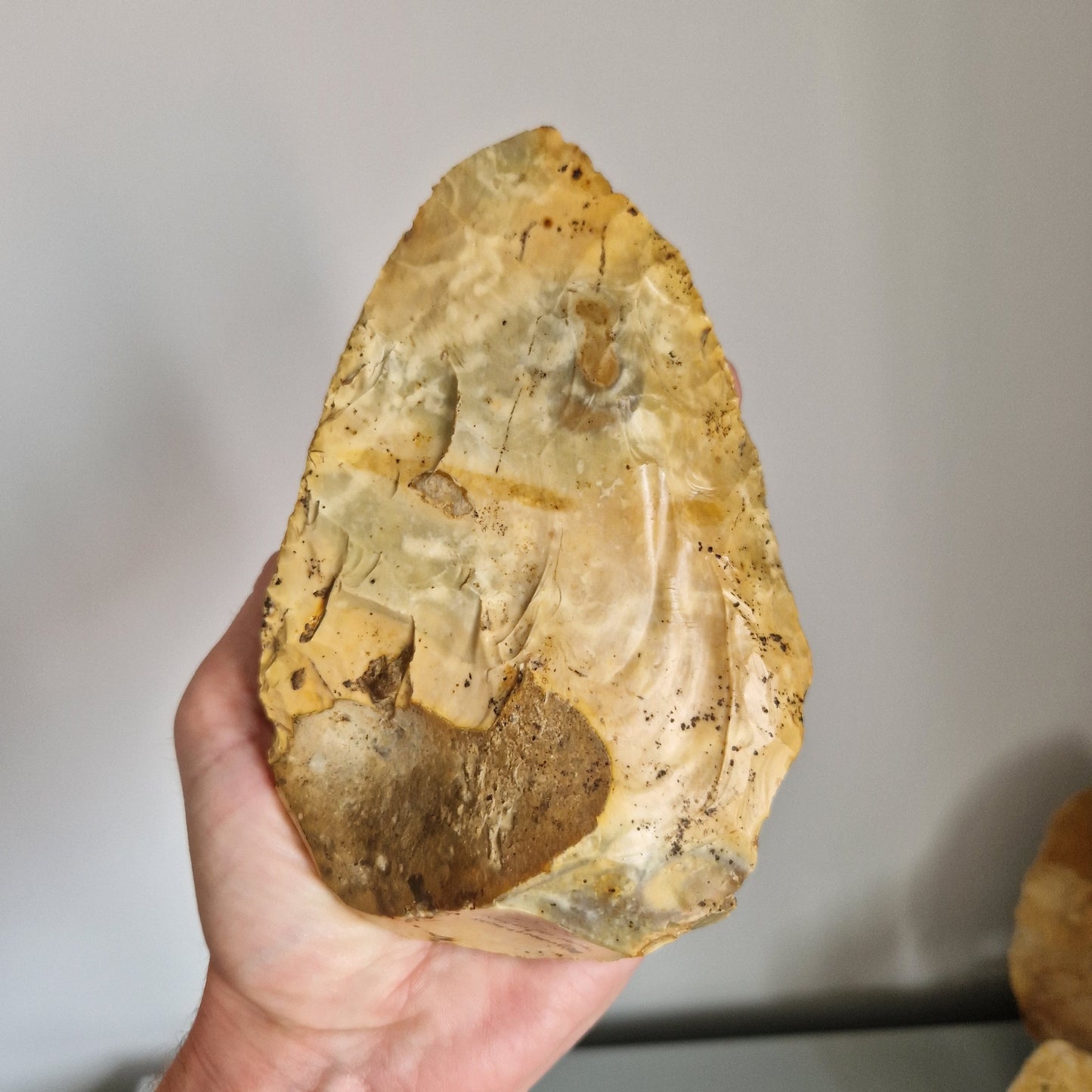Stone Age Artifacts
Neanderthal Made Middle Palaeolithic Handaxe / Biface. Beautiful Patina. From Seine et Marne, France. Stoneage
Neanderthal Made Middle Palaeolithic Handaxe / Biface. Beautiful Patina. From Seine et Marne, France. Stoneage
Couldn't load pickup availability
Middle Palaeolithic (Mousterian in Tradional Acheulean style) Flint Handaxe!
One of the prettiest I have held, absolutely beautiful shape, glassy patina, colours, provenance and size. The cutting edges are like a steak knife with intricate serrations.
Length 16cm
Width 10cm
Thickness 4.8cm
Found at Seine et Marne (77) France
Purchased from an old German collection.
Made by Neanderthal circa 350,000 to 150,000 years ago.
The patina is glassy to the touch and thr mottled cream, carrot orange and red colours make it a real one of kind.
It still has a razor sharp edge and it has been resharpened several times all those years ago to give its current form. You can see on the rear where it has been thinned down to create a new and sharper cutting edge.
There is one modern chip on the rear tip which shows the original caramel coloured flint material.
On the face of the axe the maker has skillfully worked around an indentation of the nodule leaving an area of cortex (potentially as a grip).
A real beautiful shape, very very pretty 😍
Condition is shown in pictures and video.
Prehistoric Age-
Acheulean industry
prehistoric toolmaking
Also known as: Acheulian industry
Written and fact-checked by
Article History
Acheulean industry, first standardized tradition of toolmaking of Homo erectus and early Homo sapiens. Named for the type site, Saint-Acheul, in Somme département, northern France, Acheulean tools were made of stone with good fracture characteristics, including chalcedony, jasper, and flint; in regions lacking these, quartzite might be used. During the Acheulean Stage of the early Paleolithic Period, which began between 1.7 million and 1.5 million years ago and lasted until 250,000 to 200,000 years ago, the presence of good tool stone was probably an important determining factor in the distribution of early humans. In the later stages they learned to bring stone from distant areas and thus became freer in their choice of homesites. “Tool kits” that differ in tool types reflect the varying adaptations made by early Stone Age humans to different environments.
flint biface from Saint-Acheul
flint biface from Saint-Acheul
See all media
Acheulean also spelled: Acheulian
Related Topics: Abbevillian industry Chellean industry Micoquian industry
The most characteristic Acheulean tools are termed hand axes and cleavers. Considerable improvement in the technique of producing hand axes occurred over the long period; anthropologists sometimes distinguish each major advance in method by a separate number or name. Early Acheulean tool types are called Abbevillian (especially in Europe); the last Acheulean stage is sometimes called Micoquian. Industries that existed at the same time and overlapped in geographic range, but specialized in flake tools and lacked hand axes, are known as Clactonian (England) and Tayacian (western and central Europe). Acheulean industries are found in Africa, Europe, the Middle East, and Asia as far east as Kolkata, India (East Asia was characterized by a tool tradition called the chopper chopping-tool industry).
November 3, 2015. According to the Israel Antiquities Authority, after years of excavations the remains of, the Acra, used by the Greeks more than 2,000 years ago to control the Temple Mount. Jerusalem. Archeology.
The earliest hand axes, such as those found with Homo erectus in Bed II at Olduvai Gorge in Tanzania, were crude pointed bifaces: chips were removed from both sides of a core by rapping it against a set “anvil” stone to form a sinuous cutting edge all around. In the next step a hammerstone replaced the “anvil,” and the whole surface of the core was flaked away to form an oval implement with relatively straight edges. Small flakes were sometimes removed from the edges to further straighten them. Later still, the hammerstone was replaced by bone or wood “hammers,” which removed smaller, flatter flakes and resulted in a smoother tool with a sharp, straight edge. A sinuous edge could be produced purposefully, resulting in a “saw.” In the late Acheulean, hand axes were pointed, and the butt end was often only roughly finished. Cleavers were large tools with one end squared off to form an axlike cutting edge.
In addition to hand axes and cleavers, the Acheulean industry included choppers and flakes. The latter were produced from a prepared core and could be used as knives without further change or could be chipped to make side-scrapers, burins, and other implements. Though bone and wood were probably also used as tools, little evidence of them remains, and no discussion of style can be attempted. At the beginning of the Fourth (Würm) Glacial Period, Acheulean industries were gradually replaced by (graded into) the Levalloisian stone-flaking technique and the Mousterian industry in Europe and the Fauresmith and Sangoan industries in Africa.
Share









